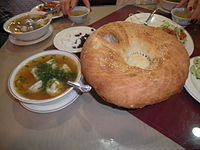Overview

The cooking of Bukharan Jews forms a distinct cuisine within Uzbekistan, subject to the restrictions of Jewish dietary laws.[1] The most typical Bukharan Jewish dish is oshi sabo (also osh savo or osovoh), a "meal in a pot" slowly cooked overnight and eaten hot for Shabbat lunch. Oshi sabo is made with meat, rice, vegetables, and fruit added for a unique sweet and sour taste.[2] By virtue of its culinary function (a hot Shabbat meal in Jewish homes) and ingredients (rice, meat, vegetables cooked together overnight), oshi sabo is a Bukharan version of cholent or hamin.
In addition to oshi sabo, authentic Bukharian Jewish dishes include the following dishes.[3]